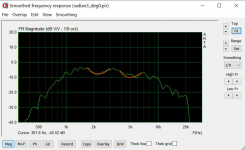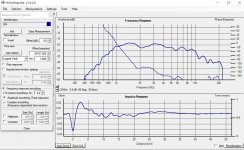Nice!This is my first attempt at taking polars. It's a small Ath4 'magic' horn with a Radian 475be. Promising?
I'd be happy if anyone had any comments.
Are the response irregularities around 2.2 kHz and 4.7 kHz due to your measuring rig/environment, or part of the waveguide behavior?
Provided there's no pronounced diffraction around the supposed listening axis.
But isn't that always the case with these newer designs? i.e. no significant diffraction from the waveguide. Seems to me that concern would be minimal.
BTW, I've been playing with free standing axisymmetric waveguides for a while and I can tell you these seem to be really the holy grail. I begin to think that making a rolled-back free standing waveguide is even better than making one built into a baffle as the rollback can be even smoother and the rest is not so important. Unfortunately the shape is not a simple closed formula anymore, which would complicate a similar optimization but maybe not that much after all.
At last 😀
It is the case with the newest axisymmetric designs by they also have tilted power response, i.e. rising DI a bit. It seems that as one tries to make the DI really constant the axial ripple and narrowing and widening start to appear no matter what. My explanation is that the (almost) conical profile needed for the "real" constant directivity is difficult to terminate as smoothly in a resonably finite size - seems logical after all. Once it is curved all the way along, even if only a little, it's much easier but also the DI rises. That said, I'm still not sure that the mildly rising DI with a flat direct response are a bad thing.But isn't that always the case with these newer designs? i.e. no significant diffraction from the waveguide. Seems to me that concern would be minimal.
Maybe with rectangular waveguides, both the constant DI and smooth listening window are possible, at least it seemed so. I'm so excited that the axisymmetric ones can also be so good that I kind of abandoned the rectangular ones for a while.
Last edited:
Please bear in mind that these are not anechoic data yet and it may thus be difficult to judge on the real waveguide behaviour.Are the response irregularities around 2.2 kHz and 4.7 kHz due to your measuring rig/environment, or part of the waveguide behavior?
What irregularities do you mean, BTW? I don't see any at those frequencies.
Last edited:
Have you ever measured a compression driver? 🙂 What you show are completely common and benign deviations from flat response, handled in crossover/EQ (and it's only +- 2dB). What's of the paramount importance is whether all the polars are the same like this, i.e. if it's really the driver that's the cause. If they are, a simple EQ corrects it all (remind you, both amplitude and time aspects together).
This would be no problem at all.
This would be no problem at all.
Last edited:
Here we go 🙂 I only don't understand what horn was measured - on the photo is that already the huge one with a 2" throat I designed? That Radian is a 1" driver, isn't it. Are you using some throat adapator, or...?
This is the small 1" that you designed for me. Actually I was using a 'screw on' adapter - and a bit skeptical as to how well it mates with the driver. I'm going to attach the driver directly and measure again. I'm new to ARTA. This is the Holm plot with phase. What measuring software do you use?
Attachments
I hope you didn't direct these questions to me because I'm with you - I was rather trying to interpret 454's observations...
//
//
Oh, did I? I almost forgot, had to look that up. Indeed, it was only about 11.5" large. Nice.This is the small 1" that you designed for me.
I still try to use Holm whenever possible. I really like the complete control over the process. In the other programs, I always feel there's something happening "behind the scene", I don't know why. In ARTA this is especially the case with the phase response calculation - I don't consider it very transparent (I have no doubts it can be used reliably). In Holm it couldn't be more open and even with a single channel it works like a charm. Great stuff, really.This is the Holm plot with phase. What measuring software do you use?
I'm only not sure that this is the right thread to consult the measurements issues per se. I'm sure there's a plenty of great help around here.
That's a long winding story - for a different thread. That one was CNC'd directly from solid. (the block was made up from mitered wedges). But I think the separate 'leaf' method is better and scales up for larger horns.maravedis - how did you shape/build this horn?
//
In Holm all you need now is to select the "Impulse time-window (gating)" option (at this point) and see. The rest is pretty intuitive. Only make sure you have as much free space around the measurement setup as possible.This is the Holm plot with phase. ...
The discussion on DI isn't quite clear to me.
Nearly all well-regarded loudspeakers have a rising DI.
Some argue a slightly rising directivity in the top octave is to be preferred in 'average', untreated rooms that aren't hall-sized.
Nearly all well-regarded loudspeakers have a rising DI.
Some argue a slightly rising directivity in the top octave is to be preferred in 'average', untreated rooms that aren't hall-sized.
Attachments
Last edited:
That could also be simply because loudspeakers with constant DI are still almost non-existent. You just choose from what you have 🙂
The coaxial Genelecs, for example, are pretty close to that target. See how they are rated.
The coaxial Genelecs, for example, are pretty close to that target. See how they are rated.
Last edited:
The Genelecs, for example, are pretty close to that target. See how they are rated.
Yes, but these are first and foremost specifically designed for (treated) studios.
Moreover, it seems fairly constant coverage is most important throughout the midrange and lower treble.
Your best efforts so far, are close to ideal wrt DI.
I would go so far as to state that above a certain DI other factors are more important to the perceived quality, such as low diffraction
One more question about the HF1440 horn: is the intersection of the real and imaginary parts above or below 1000Hz?
Last edited:
How is that incorporated into the Olive metric?Yes, but these are first and foremost specifically designed for (treated) studios.
Only after you tell me what's the use of this information 🙂One more question about the HF1440 horn: is the intersection of the real and imaginary parts above or below 1000Hz?
How is that incorporated into the Olive metric?
It's not.
Only after you tell me what's the use of this information 🙂
You know why I'm asking 😉
However, I'd be (positively) surprised if it's well below 1000Hz.
But it has the best preference score from all the loudspeakers measured at ASR, whether or not are they "specifically designed for (treated) studios". So this is not really related, is it.It's not.
No, I still didn't get it to this day 🙂You know why I'm asking 😉
- Home
- Loudspeakers
- Multi-Way
- Acoustic Horn Design – The Easy Way (Ath4)


